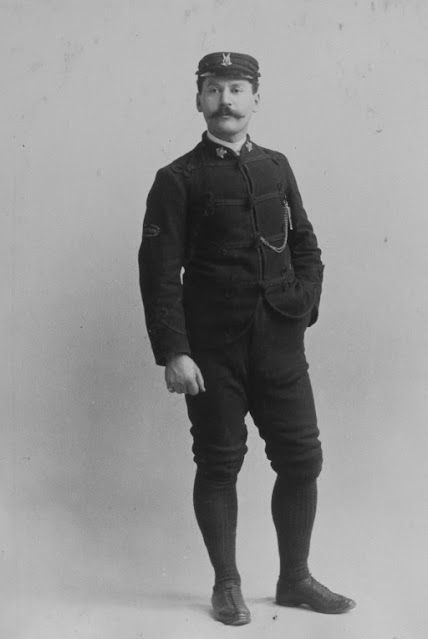Photo courtesy Bibliothèque et Archives nationales du Québec
Photo courtesyMusée McCord Museum. Reproduced for educational purposes under license permission.
Right photo courtesy Musée McCord Museum. Reproduced for educational purposes under license permission.
Although the voyage over the Atlantic was smooth sailing, what happened when Louis arrived wasn't. He checked into the Grand Hotel d'Europe and within a few days found himself summoned to the cop shop. He was interrogated and asked if he was Jewish. Responding yes, his passport was seized but he was released. Returning to practice, he was hauled back into another police station days later and told to leave the country within twenty four hours. The reason? "We cannot permit Jews to remain in St. Petersburg". Louis plead his case to the British Ambassador Sir Robert Morier, who returned his passport with the words "British Subject" crossed out and replaced with "L. Rubenstein, Jew". He was advised to compete in the World Championships but leave the country immediately thereafter.
Photo courtesy Musée McCord Museum. Reproduced for educational purposes under license permission.
Skate Louis did... in front of members of the very Emperor who opposed him (Alexander III)'s court. Part of the competition, which included school figures, special figures and specialties was won by the outcast from Canada. In winning a gold medal, he defeated skaters from Austria, Sweden, Norway, Finland and Russia. He explained his experience in letters home that were published in Montreal newspapers: "Instead of what we call our list in Canada there are three separate competitions in Russia. The real figure skating or what we call list skating goes under the name diagram skating in Russia. There are two other departments - special figures and specialties - and in these there is a tendency to acrobatic work, which would not be recognized as fine skating in Canada." Safely returning home to Montreal by way of New York, Louis retired from the sport in 1892 after capping off his career with another U.S. title for good measure.
Every bit as important to his on ice contributions to skating were Louis' off-ice ones. He was made honorary secretary of the Amateur Skating Association of Canada and would later serve as its president. He was instrumental in forming the International Skating Union of America as well and also presided over that organization. Just incredible if you ask me.
A 2004 article from the "Canadian Jewish News" also noted, "He was a populist politician who took an interest in the welfare of the poor. His decision to establish the Rubenstein Bath was of no small importance to poverty stricken Montrealers who lacked something so basic as running water.
A keen politician, Rubenstein sometimes filled in as mayor... His funeral attracted thousand of mourners. Several years after Rubenstein's passing, a group of well-heeled Montrealers raised about $2,000, no insignificant sum during the Depression, for a fountain in his memory. It was finally erected in 1937... The fountain is the only public monument in Montreal, and perhaps in Quebec, honouring a Jew."
Louis' death on January 3, 1931 marked the end of an era and the beginning of another. Only two years later in August 1933, the Christie Pits Riot broke out in a Toronto playground after a baseball game six months after Adolf Hitler took power in Germany. An account in the Toronto Star described the event: While groups of Jewish and Gentile youths wielded fists and clubs in a series of violent scraps for possession of a white flag bearing a swastika symbol at Willowvale Park last night, a crowd of more than 10,000 citizens, excited by cries of 'Heil Hitler' became suddenly a disorderly mob and surged wildly about the park and surrounding streets, trying to gain a view of the actual combatants, which soon developed in violence and intensity of racial feeling into one of the worst free-for-alls ever seen in the city. Scores were injured, many requiring medical and hospital attention... Heads were opened, eyes blackened and bodies thumped and battered as literally dozens of persons, young or old, many of them non-combatant spectators, were injured more or less seriously by a variety of ugly weapons in the hands of wild-eyed and irresponsible young hoodlums, both Jewish and Gentile". Less than a decade later, young Jewish diarist and skater Anne Frank would face her end in the Bergen-Belsen concentration camp during The Holocaust. Louis' work in fostering a better sporting world would not be for nought though. At the fountain in his honor in Fletcher's Field in Montreal, the water still flows. The water reminds one of Louis' resolve in life to flow on and on despite the hate he himself experienced in his trip to Russia and in the winter it freezes into ice, the very surface he changed the skating world upon.
This piece originally appeared as part of a six-part podcast series called Axels In The Attic. You can listen to Allison Manley of The Manleywoman SkateCast and Ryan Stevens of Skate Guard's audio version on Podbean or iTunes.
Skate Guard is a blog dedicated to preserving the rich, colourful and fascinating history of figure skating. Over ten years, the blog has featured over a thousand free articles covering all aspects of the sport's history, as well as four compelling in-depth features. To read the latest articles, follow the blog on Facebook, Twitter, Pinterest and YouTube. If you enjoy Skate Guard, please show your support for this archive by ordering a copy of the figure skating reference books "The Almanac of Canadian Figure Skating", "Technical Merit: A History of Figure Skating Jumps" and "A Bibliography of Figure Skating": https://skateguard1.blogspot.com/p/buy-book.html.










